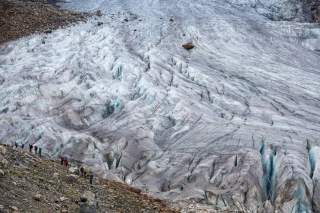1. Healthy and fit in the mountains
Alpine tours lead you into high-altitudes and require lots of endurance! The intense strain on the cardiovascular system as well as muscles and joints requires a healthy body and realistic self-assessment. Avoid time pressure and choose the right speed so that nobody in the group is strained to the limit.
2. Consider height adjustment
From 2500 meters onwards your organism needs time to adjust. A slow ascent and a moderate increase of your sleeping altitude are decisive. The best means to counteract symptoms of altitude sickness like headache, dizziness or nausea is to descent.
3. Plan your tour carefully
Maps, guidebooks, the internet and experts inform you on trip duration, difference in altitude, difficulty and current conditions. Pay special attention to the weather forecast as thunderstorm, snow, wind and cold increase the risk of accidents. Plan alternative routes! Get information on national mountain rescue emergency hotlines (Euro-emergency hotline 112).
4. Travel in small groups
Abilities, experience, motives and the size of the group are decisive for the choice of your tour. The ideal group size is 2 to 6, more people are a risk factor! We recommend not to go alone. Always inform trusted persons on destination, route and return conditions.
5. Appropriate equipment
Adapt your equipment to your destination and see to a low weight of your backpack! Rope and helmet protect you from falling and rocks, crampons and ice axes give you support. Take sun protection. For the case of emergency: first aid kit, bivouac sack, mobile telephone and headlights.
6. Check the local conditions
Glacier retreat, deglaciation and increase of the zero-degree line due to climate change increase the danger of falling rocks and falling into a crevasse. Starting early, the continuous assessment of weather and terrain situation and an accordingly adapted choice of your route are fundamental.
7. Continuous orientation
In pathless areas off the beaten track and with restricted visibility, orientation may become difficult. It is thus of utter importance to know how to deal with your map, altimeter, compass and GPS. In doubt return early enough!
8. Use a rope on the glacier and belay your partner in steep, dangerous terrain
Rock ridges, glacier, flanks of packed snow or ice require a high competence in belay and rescue techniques. In case of someone falling into a crevasse, the glacier rope team will prevent the downfall. Attention in steep terrain: there is a danger of being carried along when being roped together!
9. A sure foot is the key
Falling – as a consequence of slipping or stumbling – is the most common cause of accidents! Bear in mind that walking too fast and fatigue may strongly impair surefootedness and concentration. A secure handling of crampons and ice axes requires intensive training.
10. Respect nature and the environment
High mountain regions offer great opportunities to move freely in a unique wilderness. Enjoy that freedom and respect the highly sensitive natural environment of high mountain regions! Be considerate of others and support the alpine clubs in protecting and caring for nature and the environment.
